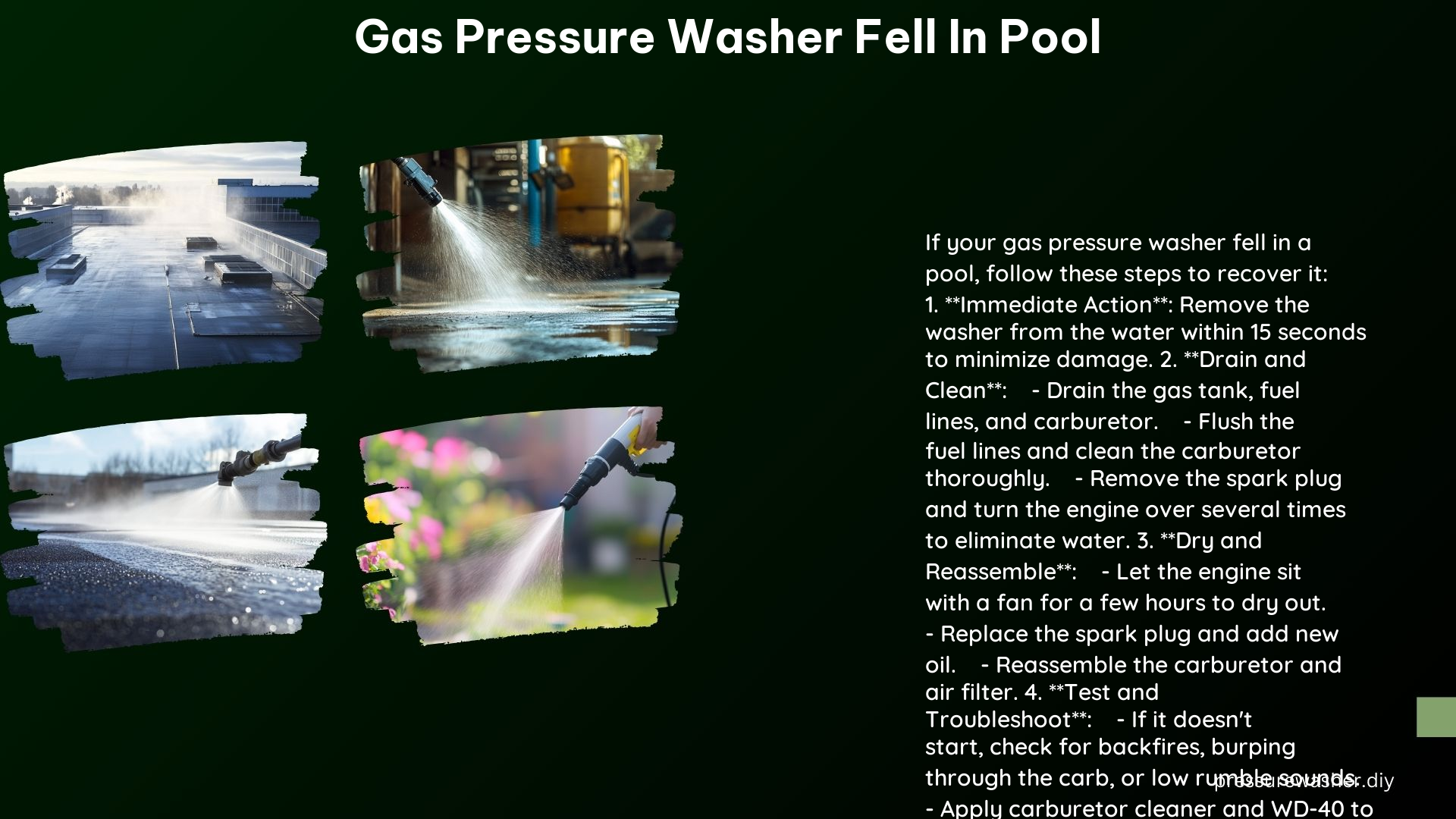If a gas-powered pressure washer accidentally falls into a pool, it’s crucial to act quickly to minimize the damage and potentially salvage the device. This comprehensive guide will walk you through the immediate steps to take, the key components to inspect and clean, and the technical specifications to consider when dealing with a gas pressure washer that has been submerged in water.
Immediate Steps to Take
1. Remove the Pressure Washer from the Water
The sooner you can retrieve the pressure washer from the pool, the better. This reduces the amount of water that can seep into the internal components, which can lead to corrosion and other issues. Ideally, you should remove the pressure washer from the water within 5-10 minutes to minimize the potential for damage.
2. Drain the Fuel Tank
Once the pressure washer is out of the water, it’s crucial to drain the fuel tank immediately. This prevents water from mixing with the gasoline, which can cause further damage to the engine and fuel system. Use a siphon or a fuel transfer pump to completely drain the tank, ensuring that no water-contaminated fuel remains.
3. Pull the Spark Plug
Removing the spark plug allows any water that has entered the engine to drain out. This helps prevent corrosion and makes it easier to start the engine later on. Use a spark plug wrench to remove the plug, and be sure to keep it in a safe place until you’re ready to reassemble the pressure washer.
4. Turn the Engine Over
Pull the recoil rope on the pressure washer several times to turn the engine over. This helps remove any water that may have accumulated in the cylinders, crankcase, or other internal components. Turning the engine over can also help dislodge any debris or contaminants that may have been introduced during the submersion.
5. Disassemble and Clean the Carburetor
The carburetor is a critical component that can be easily damaged by water. Disassemble the carburetor and clean it thoroughly using a carburetor cleaner and WD-40. This will remove any water, debris, or corrosion that may have accumulated. Be sure to follow the manufacturer’s instructions for proper disassembly and reassembly.
6. Drain the Oil
Draining the oil is essential to prevent water from mixing with it, which can cause significant engine damage. Use a drain pan to collect the old oil, and then refill the engine with fresh, high-quality oil according to the manufacturer’s specifications.
7. Dry the Pressure Washer
After completing the previous steps, use a fan or let the pressure washer sit in a well-ventilated area to dry out completely. This helps ensure that any remaining moisture is removed from the internal components, reducing the risk of corrosion and other issues.
Salvaging the Pressure Washer

The success of salvaging a gas pressure washer that has fallen into a pool depends on the extent of the damage and the promptness of the actions taken. If the pressure washer is not too severely damaged, following the steps outlined above can help restore it to working condition.
Key Components to Inspect and Clean
-
Carburetor: Disassemble and clean the carburetor thoroughly to ensure it is free from water and debris. Check for any signs of corrosion or damage, and replace the carburetor if necessary.
-
Fuel Tank and Lines: Drain and clean the fuel tank and fuel lines to prevent water from mixing with the gasoline. Inspect the tank and lines for any cracks, leaks, or other damage.
-
Spark Plug: Clean or replace the spark plug to ensure proper engine function. Check the gap and replace the plug if it is damaged or worn.
-
Oil: Drain and replace the oil to prevent water from mixing with it. Use the recommended oil type and quantity specified by the manufacturer.
-
Air Filter: Clean or replace the air filter to ensure proper airflow and engine performance. A clogged or damaged air filter can lead to engine issues.
-
Cylinder and Crankcase: Inspect the engine’s cylinder and crankcase for any signs of water intrusion or corrosion. If significant damage is found, the engine may need to be rebuilt or replaced.
-
Electrical Components: Check the ignition coil, wiring, and other electrical components for any water damage or corrosion. Replace any damaged parts to ensure the pressure washer’s electrical system is functioning properly.
Technical Specifications
The technical specifications of a gas pressure washer that has fallen into a pool will vary depending on the specific model and brand. However, some common technical details to consider include:
- Engine Displacement: Typically ranging from 160cc to 389cc for residential-grade gas pressure washers.
- Pump Type: Axial cam, triplex, or wobble plate pumps are commonly used in gas pressure washers.
- Maximum Pressure: Ranging from 2,000 PSI to 4,200 PSI, depending on the model.
- Water Flow Rate: Typically between 2.0 GPM to 4.0 GPM.
- Fuel Tank Capacity: Ranging from 0.5 gallons to 1.5 gallons, depending on the engine size.
- Oil Capacity: Typically between 15 ounces to 32 ounces, depending on the engine displacement.
It’s important to consult the manufacturer’s specifications for your specific gas pressure washer model to ensure you are using the correct replacement parts and following the proper maintenance and repair procedures.
Reference:
- https://www.autogeekonline.net/forum/auto-detailing-101-a/54800-pressure-washer-fell-water-while-cleaning-boat.html
- https://www.houzz.com/discussions/1610193/pressure-washer-fell-in-pool
- https://www.hobbytalk.com/threads/pressure-washer-fell-in-pool.425514/
